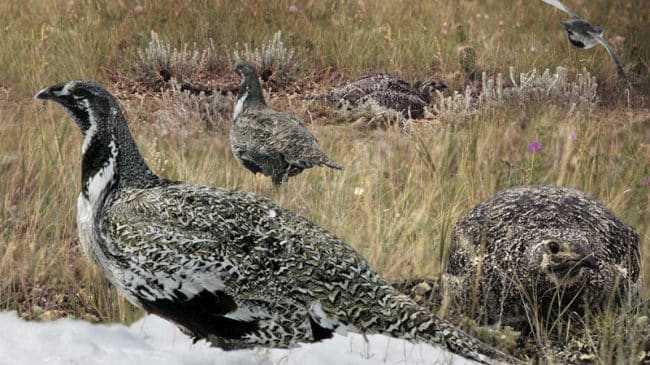The Department of the Interior is engaged in what it describes as “the largest and most complex landscape-scale land management planning effort in US history-and the most ambitious conservation experiment under the ESA [Endangered Species Act].” The object of this extraordinary attention is the greater sage grouse, a large ground-dwelling bird that inhabits 165 million acres in 11 western states.
The Interior Department has a September 30, 2015 deadline to decide whether to propose listing the greater sage grouse under the Endangered Species Act. However, the Department has strongly suggested-and it has also been reported-that listing could be precluded by 15 amended federal plans governing the use of 61.5 million acres of federal land located in sage grouse habitat.2 This aspect of the sage grouse story, in which 98 land use plans have been combined into 15 “mega” sage grouse-specific plans, is very significant but has generally received less attention than a potential listing under the Endangered Species Act.
Communities, landowners, ranchers, states and businesses are very worried that they will be restricted by penalties and severe controls on land and resource use. Two separate studies commissioned by the Western Energy Alliance estimate the effects of sage grouse regulations, due to a potential listing under the Endangered Species Act and the 15 amended federal plans, on annual economic losses (revenues, taxes, earnings and economic output) and annual jobs losses:
- Endangered Species Act listing (oil and gas industry): $5.5 billion and 18,000 jobs
- 15 amended federal plans (all sectors of the economy): $7.7 billion and 31,000 jobs
With the stakes so high, a closer look at the sage grouse, its population status and conservation measures taken to help the species is warranted.
The greater sage grouse currently has a minimum population of almost 425,000 and a positive population growth rate of 0.78% annually from 2005-2015, according to a recent report by the Western Association of Fish and Wildlife Agencies.5 Longer term, it appears that the range-wide sage grouse population trend is similar to that in Wyoming. From when data collection began in the 1950s and 60s, the sage grouse population in Wyoming initially declined but have experienced “a general leveling off since the mid-1990s,” according to Tom Christiansen, sage grouse coordinator for Wyoming’s Game and Fish Department.
Despite this trend, along with the increase over the past decade, there is controversy over whether sage grouse populations are increasing or decreasing, much of which is due to the time frame, or frames, used to evaluate the population. There are widespread claims of long-term sage grouse decline, which tend to rely on a single declining trend, beginning at the 1960s or 1980s, to the present. A more accurate method to evaluate the population is to look at the three chronological trends within the past 50 years: decline, stabilization, and increase over the past ten years.
The larger point is the greater sage grouse is doing well and does not meet any reasonable standard for listing under the Endangered Species Act, or for amending land use plans for 61.5 million acres of federal land to give sage grouse considerations primacy in the management of these lands.
The greater sage grouse’s population has stabilized and then gradually increased over the past two decades due primarily to more favorable weather conditions. Sage grouse populations naturally fluctuate on roughly 10-year cycles, most notably in response to rainfall: when there is more rain, populations tend to increase; when there is less rain, populations tend to decrease. Successful conservation efforts have likely been a secondary contribution to the increase in sage grouse population. Given that weather conditions were not changed by federal agency actions, the relevant issue is what conservation efforts helped the sage grouse population stabilize and increase over the past two decades.
